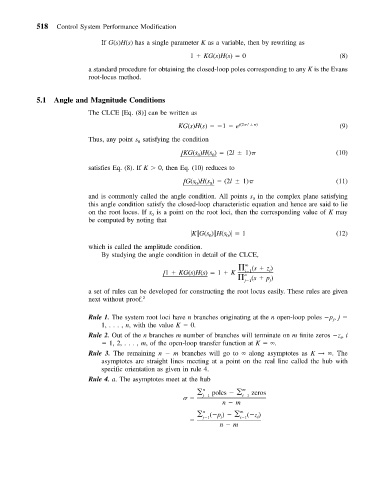Page 527 - Mechanical Engineers' Handbook (Volume 2)
P. 527
518 Control System Performance Modification
If G(s)H(s) has a single parameter K as a variable, then by rewriting as
1 KG(s)H(s) 0 (8)
a standard procedure for obtaining the closed-loop poles corresponding to any K is the Evans
root-locus method.
5.1 Angle and Magnitude Conditions
The CLCE [Eq. (8)] can be written as
KG(s)H(s) 1 e j(2 / ) (9)
satisfying the condition
Thus, any point s 0
/ KG(s )H(s ) (2l 1) (10)
0
0
satisfies Eq. (8). If K 0, then Eq. (10) reduces to
/ G(s )H(s ) (2l 1) (11)
0
0
and is commonly called the angle condition. All points s in the complex plane satisfying
0
this angle condition satisfy the closed-loop characteristic equation and hence are said to lie
on the root locus. If s is a point on the root loci, then the corresponding value of K may
0
be computed by noting that
K G(s ) H(s ) 1 (12)
0
0
which is called the amplitude condition.
By studying the angle condition in detail of the CLCE,
m (s z )
/ 1 KG(s)H(s) 1 K i 1 i
j 1 (s p )
n
j
a set of rules can be developed for constructing the root locus easily. These rules are given
next without proof. 2
Rule 1. The system root loci have n branches originating at the n open-loop poles p , j
j
1,..., n, with the value K 0.
Rule 2. Out of the n branches m number of branches will terminate on m finite zeros z , i
i
1, 2,..., m, of the open-loop transfer function at K .
Rule 3. The remaining n m branches will go to along asymptotes as K → . The
asymptotes are straight lines meeting at a point on the real line called the hub with
specific orientation as given in rule 4.
Rule 4. a. The asymptotes meet at the hub
n poles m zeros
j 1 i 1
n m
n ( p ) m ( z )
j 1 j i 1 i
n m

